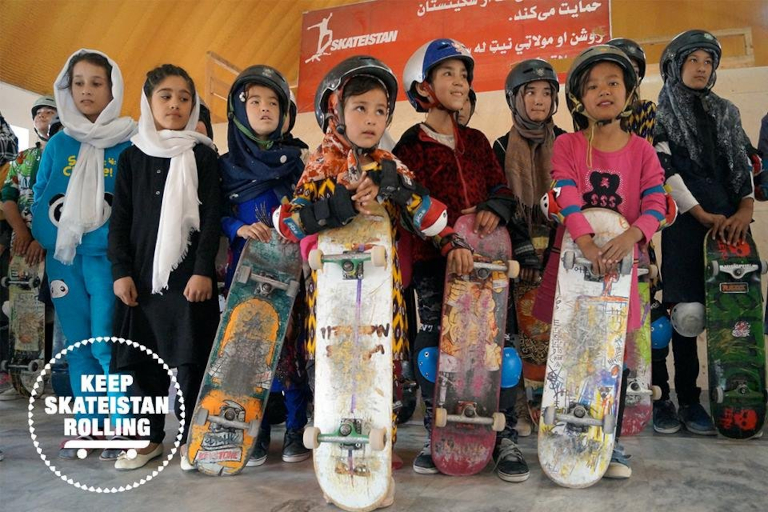Copyright Resilience

Darwinian evolution works on mutations – variables in the genetic code which may be beneficial under certain circumstances or deleterious in others. Similarly, cultural evolution builds on behavioral mutations – on radical exceptions – in the codified traditions and practices of society. As “Worst-case Scenario” conditions in rapid global change become realities before our eyes, exceptions to socially-reinforced “rules” are critical. I have long regarded the growth, mission, and progress of Skateistan as among one of these exceptions: a rapidly growing, progressive effort towards social stabilization in the midst of modern war and ecological collapse. I have followed its expansion as an uplifting example of the emergence of resilient social action under devastating conditions. Recently, while deferring my attention from the overwhelming news of increasing conflicts in the middle east, mass coral bleaching, abrupt climate change, and social upheaval in the United States, I happened across a fresh announcement from Skateistan titled, “Rolling towards peace at Skateistan.” The post explains, “Skateboarding isn’t the answer to everything. It doesn’t stop wars, fix societies, fight climate change, at least not directly. But what it can do… is carve out small but powerful spaces of peace, connection and community all over the world,” ending with a challenge to readers to “imagine what we could do if we connected all those spaces together?” While the practice of skateboarding may seem at first glance as completely arbitrary in the fields of existential ecological and social threats, in the example of Skateistan it has already demonstrably provided a foundation for community efforts supporting health, environmental education, and resilience in the midst of the extreme chaos of war, serving as a positive example of progressive social growth within chaotic conditions. As Skateistan recognizes, skating does not directly address the enormous catastrophes wrought by modern nation states and market powers, but it seems to have the ability to unite individuals cross-culturally to create progressive non-state networks originating from within the most treacherous, violent conditions, with a mere fraction of the support granted to the established global authorities tasked with addressing global conflict and our planet’s welfare. I had the chance to interview Skateistan founder Oliver Percovich to further elucidate the history, accomplishments and future of the project. Hi Oliver, and thank you for your work at Skateistan! Could you please provide our readers with a brief history of the project? Skateistan started in 2007 when I arrived in Afghanistan, looking for a job but carrying a skateboard. Kids in the streets of Kabul were interested to try my skateboard and I was fascinated that girls were also keen to skateboard. Myself and a few mainly Afghan volunteers started to run little skate sessions in an empty fountain that focused on girls’ inclusion and soon we had also helped some of these children to stay in school. Because it would be easier for teenage girls to skate indoors with no male presence, we successfully raised money for an indoor facility to be built with classrooms and a skatepark on the Afghan Olympic Committee grounds. This was the first Skate School and we went on to build other Skate Schools in Mazar-e-sharif, Bamyan, Phnom Penh and Johannesburg. In 2018, we started to think beyond just Skate Schools and how we could assist the whole social skateboarding sector of grassroots organizations that were using skateboarding for positive change. We decided to share our knowledge (at no cost) so that other social skate organizations could know what we know and also have the impact we were having, in their own communities. This incubator was called Goodpush. We started a pivot towards locally run Skate Schools in 2016, but in 2022 we made a break, allowing all Skate Schools to be independent Program partners. Skateistan then added on new Program Partners from the Goodpush network. Along the way we have worked with over 30,000 children in our programs, had loads of amazingly talented people work for Skateistan and won lots of prestigious awards. We now have program partnerships in forty-nine locations and the Goodpush Alliance has 1020 partner projects in 115 countries. I’m very proud that for a brief moment in 2014 skateboarding was the largest sport for girls in Afghanistan through our work. The first 18 years have been a blast and I feel very lucky to have found such meaningful and impactful work. What are some of the education and environmental awareness aspects that have been incorporated into your curriculum at Skateistan? Skateistan has had environmental topics in our education curriculum since the very start. The first classroom based session that I ran in our new facility in Kabul in 2009 was on “The Greenhouse Effect” which is how climate change was talked about 20 odd years ago. I had studied Environmental Management in the 1990’s and I thought it vitally important to teach Afghan youth about environmental issues. They had mostly diesel generated electricity with no solar or wind options, polluted air and rivers, erosion from deforestation, species loss, and so many issues that the children were not aware of. Over the years doing clean ups in their neighborhood, up cycling skateboards and making art projects from rubbish have all been popular activities. I know there are several skate deck companies making environmentally friendly boards from bamboo (a fast growing invasive species in many regions), are you aware of other examples of direct connections between skateboarding and recycling/upcycling/sustainable material use? One example is wheels that are upcycled into fabric that can be used to make wallets and bags called Shred Cycle. While there are examples, I think there is a long way to go for the skate industry to become more eco-friendly. We need to get to closed-loop recycling of all skate industry products. Skateboard culture has historically embraced a wide array of characters: artists, outcasts, punks, and various subgroups of modern society, embracing creative and rebellious types while still including rigorous, high performing athletes. What elements of skating do you see as cross-culturally appealing on the global scale? I think the way that skateboarding builds vibrant, diverse and entrepreneurial communities is appealing to many people the world over. These new skate communities might not always be embraced by entrenched power, but sometimes that’s the point of them. Can you give us an insight into which projects Skateistan supports which are actively engaging in migrant or displaced communities, and how they engage with these? Poverty pushes families from rural areas to cities with the parents looking for jobs in Johannesburg and Phnom Penh. In Afghanistan, active war forced many children who we served to flee to the cities of Kabul and Mazar-e-sharif. Displaced youth are targeted for programs through visiting IDP camps for recruitment. We then sent transport to these camps and brought the students in for Back to School sessions or other programming. In the future we will see more climate related migration and girls are the group most negatively impacted. Experts currently estimate at least 143 million more climate refugees to be displaced across Sub-Saharan Africa, Latin America, and South Asia in the coming decades, and around 1.2 billon people displaced globally by 2050. In the future, how might NGO’s such as Skateistan evolve to respond to these new challenges? Climate migration will not be one time migration, rather a series of ongoing steps. NGO’s will have to rethink permanent structures or bases and have better ways to address needs that may be temporary. Pop-up programs, programs less reliant on equipment, online services to climate migrants. Any future needs will be best met by asking a lot of questions now of people that have undergone multi-country migration. These people are the real experts, not someone that has studied International Development or only worked for an international NGO. What are some of the hardships you’ve faced throughout the inception and growth of Skateistan? Staff and students dying from suicide attacks in Afghanistan is by far the hardest thing that I’ve ever had to deal with. Overall what is hard growing an organization for impact is that you have to put yourself in a mode of continuously learning, which can feel exhausting. Not everyone finds a learning environment easy. We also have to take significant risks to be effective at the work we do. This isn’t for everyone, so I am very grateful to the amazing people at Skateistan that change the lives of children who are living in poverty, who are marginalized and living with the horrors of war. It seems that current escalation in large scale wars insights political radicalization of internal populations, generating a feedback loop in violence and direct confrontation. Has this become more evident in regions where Skateistan operates? In many of the places where Skateistan operates there is already widespread violence and other significant problems in society so it is hard to gauge. A good analogy is COVID-19 where a lot of the world experienced significant upheaval. It almost didn’t register as an issue in Afghanistan as they had bigger fish to fry. As indicated by the increasing protests and destabilization in the US and other developed countries, the need for systemic social transformation is obvious. How have you witnessed the community and collaboration through skateboarding bridge cultural and polarizing tribal tendencies? I don’t live in the US so this is a bit hard to answer. I would say that skateboarding always felt like a space that was largely non-political. The polarization of US politics has definitely infected skateboarding in the US as well. I’d love to see a project bringing together skateboarders of different political stripes. The best examples of skateboarding bridging cultures is the work done by indigenous skateboarding groups like Stronghold Society led by Walt Pourier, Nations Skate Youth, Colonialism Skateboards in Canada and Songlines, Spinifex in Australia. What support can readers direct to your current efforts, and what message would you like to end our discussion? We will never stop pushing. This is a movement to give at-risk youth everywhere the spaces and resources they need to learn, play and shape their futures. If you want to be a part of this global movement for real, lasting change, then please become a Citizen of Skateistan. It’s as easy as giving a dollar a month via our website, skateistan.org – We want you onboard. Teaser image credit: Author supplied.



